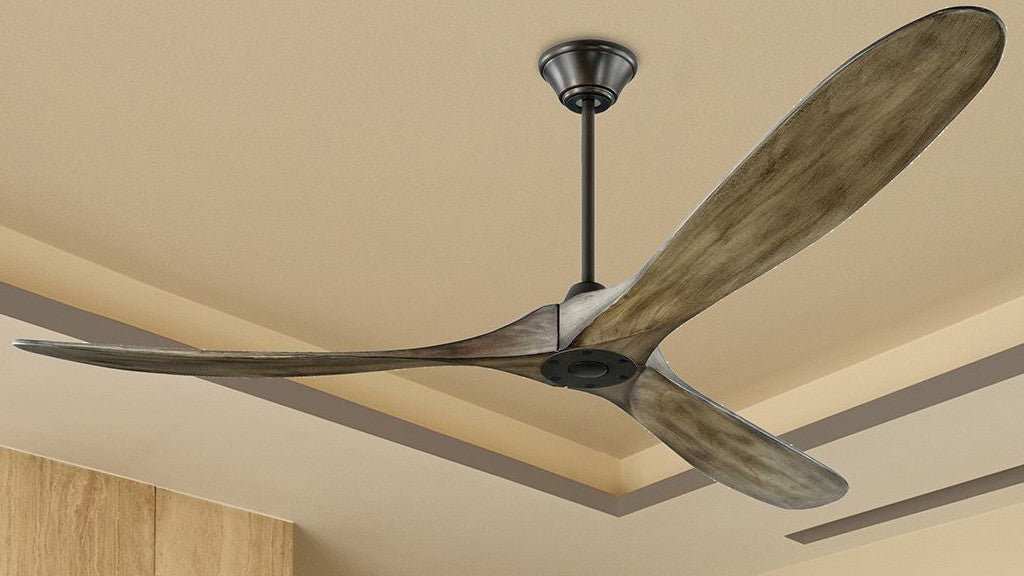
Ceiling Fan Rotation Guide
Search

Ceiling Fan Rotation in Winter
Optimal ceiling fan rotation in winter requires that blades rotate in a clockwise direction. Thie clockwise ceiling fan rotation creates an updraft that forces the warm air near the ceiling down into the room. The air at the ceiling is 15 degrees warmer than that near the floor, so having the wrong ceiling fan rotation will actually make heating less efficient. Getting ceiling fan rotation to move the warmer air down to the floor creates comfort at a lower thermostat setting. Also, account for the wind chill and use the fan at low speed.
In the summer, ceiling fan rotation should be adjusted to rotate in a counter-clockwise direction. This ceiling fan rotation creates a downdraft making you feel cooler and keeping your energy costs down.
How much air should my ceiling fan move?
 CFM is the measurement of air circulated by a ceiling fan measured in the amount of air moved in cubic feet per minute.
CFM is the measurement of air circulated by a ceiling fan measured in the amount of air moved in cubic feet per minute.
Ceiling fan direction & motor guide
Beyond ceiling fan rotation, you must also consider fan direction as a critical component to getting the most out of your fans. Typical ceiling fan motors range in power between 1/60 and 1/3 hp (horsepower). Motors that are more powerful are often found in ceiling fans with wider blade spans and greater blade pitch. These larger motors also reduce the instance of overheating.
Always look for ceiling fan motors with sealed bearings. This eliminates the need to oil the bearings and perform additional motor maintenance. Another thing to be aware of is a rubber flywheel. The rubber flywheel controls torque and stabilizes the ceiling fan. It also makes for quieter fan operation. Some inexpensive ceiling fans do not have these key components.
Most ceiling fans feature a reverse motor and airflow switch, letting you operate the fan year round. The control is usually on the fan’s housing. Refer to your owner’s manual to locate your switch. Remember to adjust your thermostat when using your ceiling fan to help save you energy and money.
Ceiling Fan Blade Cleaning Tip from the PROS!
Ceiling fans are a great way to stay cool in the summer and re-circulate hot air in the winter. But those fan blades can sure collect dust over time! Cleaning them can be a pain.
Here are two clever tricks to help you keep your ceiling fan blades clean and running great
It’s In The Bag! Take an old pillow case and get it a little bit damp. Put the case over each blade one at a time (like a pillow). Then gently pull it off and you pull the dust and dirt off without having it go everywhere and it all stays in the pillowcase.
Socks Work Great! For the really dirty fans that need some extra attention take an old pair of cotton socks and dip them in some soapy water made with dish detergent. Ring them out so they are just damp. (remember we are working with an electrical fixture) Put them over your hands and then run your hands over the top and bottom of each blade. The dust will stick to the wet socks and it takes just minutes.
Ceiling Fan Glossary
- Airflow: measured in cfm; the higher the product’s airflow and airflow efficiency (cfm/watt), the more energy-efficient it is
- Airflow Efficiency: measured in cfm per watt. The higher the product’s airflow (cfm) and airflow efficiency, the more energy-efficient it is.
- Bearings: Ceiling fan bearings separate the moving part of the motor from the housing that surrounds it and reduce friction and wear. Bearings in ceiling fans are precisely formed spheres of hard metal or composites that revolve as the motor spins against them. High-quality bearings contribute to vibration-free operation, quiet and long life.
- Blade Pitch: The angle of the blades on a ceiling fan. Pitch helps determine the efficiency of the air movement produced by the ceiling fan.
- Blade Sweep: Diameter of your ceiling fan from blade tip to blade tip.
- CFM: cubic feet per minute; a measurement of airflow
- Damp-rated: UL or ETL rated for damp, humid, or covered exterior locations. Includes moisture-resistant motor and finish and stainless steel hardware. Must be used with All-Weather or outdoor blades.
- Downrod: The ceiling fan downrods are the pipe that suspends the fan from the ceiling box. Most fans include a very short downrod, but other lengths and extenders are usually available so you can hang the fan to your desired height. A ceiling fan's distance from the ceiling is critical for maximum efficiency, and is typically determined by downrod size. See above for proper sizing of downrods.
- ENERGY STAR® : Products that qualify as ENERGY STAR® prevent greenhouse gas emissions by meeting strict energy efficiency guidelines set by the U.S. Environmental Protection Agency and the U.S. Department of Energy. ENERGY STAR®-qualified ceiling fans optimize the pitch angle for maximum air delivery at the lowest power consumption. What does this mean for an energy-conscious consumer? The higher the product’s airflow (measured in cfm) and airflow efficiency (cfm/watt), the more energy-efficient it is.
- Hugger: informal term for a fan with a low-profile design in which the motor housing is flush with the ceiling (e.g., Silhouette II and Four Seasons III Hugger). The lack of a canopy and downrod make this style ideal for use on a low ceiling.
- Light Kit: Ceiling fan light kits are accessories that attach to the bottom of a fan. There are a variety of styles and light outputs you need to consider when choosing your fan.
- Motor: The heart of every ceiling fan is the motor. Most fan motors can be reversed to change the airflow pattern. The quality of a ceiling fan is heavily determined by the quality of the motor.
- Unipack: fans that come with light kits and blades.
- Uplight: A fixture that shines light upward
- Wet-rated: UL or ETL rated for wet locations (outdoor deck, patio, sunroom, veranda, etc.). Includes moisture-resistant motor with enclosed housing, moisture-resistant finish, and stainless steel hardware. Must be used with All-Weather or outdoor blades. Wet-rated fans can be hosed down.
Explore Topics

Comments